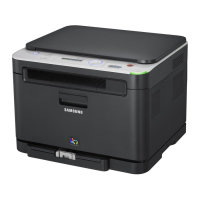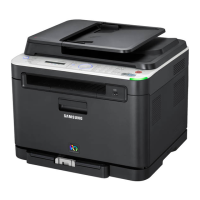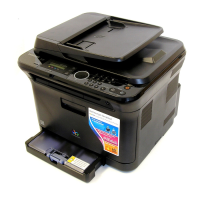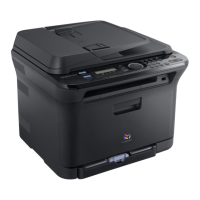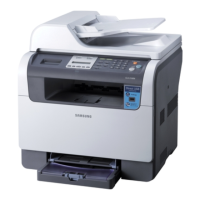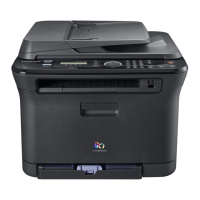Do you have a question about the Samsung CLX-3180K and is the answer not in the manual?
Provides an overview of the machine's components for different models.
Details the functions of each button and indicator on the control panel.
Explains the meaning of the machine's status LED colors and patterns.
Describes the function of key buttons like Menu, Power, and Print Screen.
Explains how to interpret toner status indicated by LEDs and the display.
Provides step-by-step instructions for physical hardware setup.
Guides on installing necessary software from the CD or website.
Lists the minimum system requirements for Windows, Macintosh, and Linux.
Detailed steps for installing the printer driver for USB connections.
Instructions for setting up local network sharing of the printer.
Details network interface and operating system requirements.
Describes programs like SyncThru™ Web Service for network management.
Guides on setting up network protocols for wired connections.
Steps for installing drivers for machines connected via network cable.
Explains how to configure IPv6 settings for network communication.
Overview of wireless network options and considerations.
Explains Ad-Hoc vs. Infrastructure modes for wireless connection.
Steps to easily set up wireless connection using WPS button.
Procedure for configuring wireless settings using a USB cable.
Guides for setting up connection via an access point (Windows/Macintosh).
How to set altitude for optimal print quality.
Steps to change the language displayed on the machine.
Procedure to set the machine's date and time for fax/print jobs.
Configures key sounds, alarm sounds, speaker, and ringer volumes.
How to set default paper size and type from control panel or computer.
Instructions for loading documents on the scanner glass or document feeder.
Guidelines for choosing appropriate paper types for printing.
How to adjust paper guides for different media sizes in the tray.
Step-by-step guide for loading paper into the machine's tray.
Information on printing various media like envelopes, labels, and transparencies.
Describes software like Samsung AnyWeb Print and Easy Color Manager.
Overview of standard and special printing features supported by drivers.
General steps for printing documents from applications.
How to access and change print settings via the Printing Preferences window.
Steps to cancel a print job that is waiting in the queue.
Details features like printing multiple pages per sheet, posters, and booklets.
Standard procedure for making copies using the machine.
How to adjust settings like Darkness, Original Type, and Reduce/Enlarge.
Instructions for copying both sides of an ID card onto a single page.
Details features like N-up copying, poster copying, and clone copying.
Setting options for collating copies or sorting output.
Overview of scanning options via USB or network.
Steps to scan documents and send them to your computer.
Instructions for scanning and sending documents via email over the network.
Customizing scan settings like size, resolution, and format.
Setting default scan options to avoid repeated configuration.
Registering and managing email or fax addresses in the address book.
Using the software for scan settings and file management.
Steps to connect the machine for faxing.
Sending and receiving faxes directly from your computer.
Instructions for sending faxes directly from the machine.
Explains different modes for receiving faxes automatically or manually.
Optimizing settings like resolution and darkness for fax quality.
Setting up to forward sent or received faxes to other destinations.
Managing fax numbers for speed dial and group dialing.
Explains the use and capabilities of USB memory devices with the machine.
Instructions for inserting and connecting USB memory devices.
Steps to scan documents and save them to a USB device.
How to print files directly from a USB memory device.
Procedure to back up machine settings to a USB memory device.
How to delete files, format the device, and view memory status.
Customizing fax system settings like redialing and receiving modes.
Setting default options for copying jobs like resolution and darkness.
How to print various reports like configuration, supplies, and fax history.
Instructions for selectively clearing machine memory contents.
Configuring network parameters like TCP/IP, Ethernet speed, and Wireless.
Provides a map of the control panel menus and their options.
Overview of tools for convenient machine operation.
Accessing and using the embedded web server for machine management.
Monitoring machine status and customizing settings via the Smart Panel software.
Utilizing SmarThru software for scanning, image editing, and printing.
Configuring machine devices using the Linux driver utility.
How to adjust color settings for better print quality.
Steps to locate the machine's serial number for service or registration.
Instructions for cleaning the machine's exterior and interior components.
Procedure for cleaning the scanner glass and ADF components.
Recommendations for storing toner cartridges to maintain quality and life.
How to check the lifespan of parts like imaging unit and fuser.
Steps to improve print quality by redistributing toner.
Advice on media selection and handling to prevent paper jams.
Detailed instructions for clearing jams from different locations in the machine.
Guides on interpreting error messages and their suggested solutions.
Lists common issues and directs to relevant troubleshooting sections.
Information on ordering Samsung-authorized supplies and parts.
Lists types of supplies available for the machine.
Lists maintenance parts that require periodic replacement.
How to check the estimated lifespan of consumable parts.
Step-by-step guide for replacing the toner cartridge.
Instructions for replacing the imaging unit when its lifespan expires.
Procedure for replacing the waste toner container.
Details physical dimensions and weight of the machine.
Provides operating temperature, humidity, and noise level specifications.
Lists power requirements and consumption details.
Details supported paper types, sizes, weights, and capacities.
| Brand | Samsung |
|---|---|
| Model | CLX-3180K |
| Category | All in One Printer |
| Language | English |
